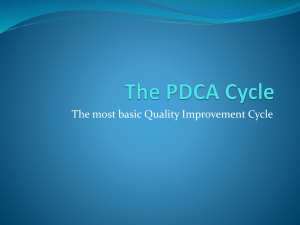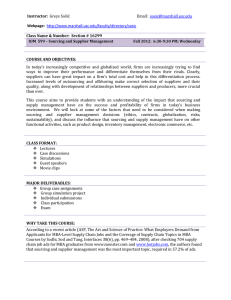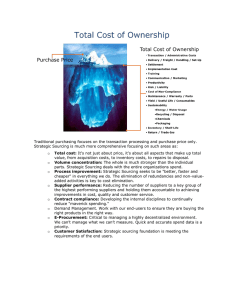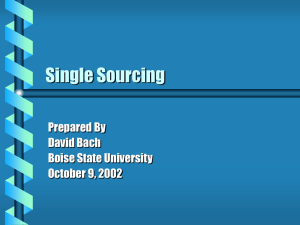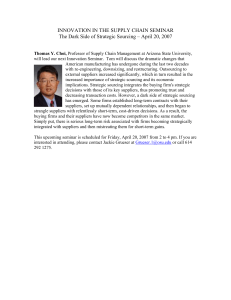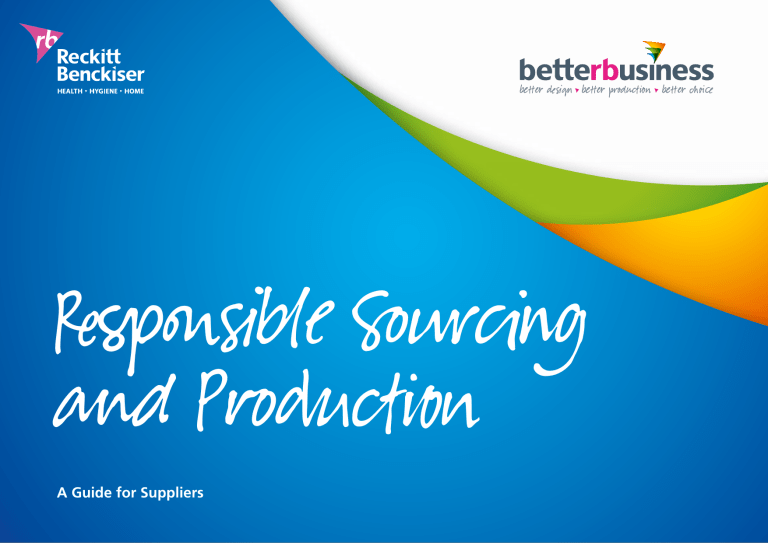
Responsible Sourcing Responsible Sourcing and Production and Production A Guide for Suppliers A Guide for Suppliers About this guide This guide provides an overview of the minimum environmental and social standards we expect our suppliers to meet. It also outlines how we will check suppliers are complying with these standards and explains why compliance is important for both our and our suppliers’ businesses. Contents 1 Introduction 2 What do we expect from our suppliers? 3 How do we check compliance with our requirements? 4 Principles for responsible production 5 Responsible natural raw materials sourcing 6 RB & sustainability 7 What you need to do & where you can find further information This is an interactive PDF Use the menu bar on the right hand side of each page for easy navigation around this document. The contents list is also interactive. Links to websites and appendix items appear throughout this document. Printing this guide lease be mindful of the pages you print. Avoid waste; only print P the pages you wish to read and print double sided. Colourful, full bleed backgrounds in this PDF will revert to white when printed. 2 Responsible Sourcing & Production – Supplier Guide RB is committed to sustainability “Sustainability is embedded in our business purpose, which is to make a difference by giving people innovative solutions for healthier lives and happier homes. We have an excellent record: 16% less water use since 2000, carbon emissions per dose of product down by 21% since 2007 and workplace accident rate down by 92% since 2001. But we’re aiming for even better performance. We’ve set ambitious new sustainability targets, which include 100% compliance with our social standards and 100% responsibly-sourced natural raw materials by 2020. We’re calling it betterbusiness and our suppliers have a crucial part to play in making it happen.” “As a supplier of goods or services to RB, we expect you to meet environmental and social standards that will help your business and ours. This guide will help you understand and meet our expectations. Rest assured that we apply the same standards to our own operations and have strict processes to make sure we comply. Thank you in advance for your cooperation and commitment to sustainability.” Amedeo Fasano Executive Vice President Supply, Reckitt Benckiser 1 2 3 4 5 Rakesh Kapoor Chief Executive, Reckitt Benckiser 6 7 3 Responsible Sourcing & Production – Supplier Guide Back to previous page 2. What do we expect from suppliers? As a supplier to RB, we expect you to comply with three sets of requirements, which form a standard part of our contracts: 1. Our Code of Business Conduct 2. Our Global Manufacturing Standard for responsible production (‘GMS’) 3. Our Policy & Standard for the responsible sourcing of natural raw materials Frequently Asked Questions Why must I meet your minimum sustainability standards? 1. It is RB’s policy and the requirement to comply will be included in your contract. 2. It will help your business to: • Minimise the risk of non-compliance with local legal requirements. • Access key global customers who have high sustainability standards. • Minimise the risk of supply chain interruption (for example, from Environment, Health & Safety (EHS) incidents or labour disputes). We are also keen to work with suppliers on other important topics, especially carbon emissions and water. If you are interested in working with us on these or other sustainability challenges, contact us at sustainability@rb.com • Improve worker productivity and retention as a result of better working conditions and fair terms of employment. The columns below summarise the three key requirements. • Minimise the risk of damage to your reputation from sustainabilityrelated issues (such as poor working conditions). 1 2 3 RB’s Code of Business Conduct As a supplier to RB you must comply with our Code of Business Conduct. It sets out RB’s principles and ethical values: • Compliance with laws, regulations and our company policies • Ethical business conduct and fair dealing • Anti-bribery and corruption • Protecting employee and contractor human rights, ensuring equal opportunities, no discrimination and a safe and healthy working environment • Avoiding conflicts of interest Responsible sourcing standards for natural raw materials We expect suppliers to comply with the minimum social and environmental standards set out in our GMS policy. If you supply natural raw materials for use in RB products or packaging, you need to comply with these standards. They set minimum requirements for natural raw materials used in RB’s products and packaging, such as palm oil, paper and board, latex and leather. Key requirements are: The key principles are: • No child labour. Limitation of work by young workers • No forced labour • A safe and healthy working environment • Freedom of association (or allow other means where such activities are restricted under law) • Protecting the environment • No discrimination. Equal opportunities and rights • Setting clear environmental and social requirements for suppliers (our GMS) • Reasonable terms and conditions of employment Reckitt Benckiser has a confidential Whistleblower Policy and process in place to encourage the reporting of any non-compliance with our Code of Business Conduct. Our Code of Conduct and Whistleblower Policy are available here: www.rb.com/Our-responsibility/Our-policies-reports 4 RB’s Global Manufacturing Standard for responsible production (GMS) Responsible Sourcing & Production – Supplier Guide • Protection of the environment These principles are underpinned by detailed requirements, available here: www.rb.com/Our-responsibility/Our-policies-reports Section 4 of this guide also has more details. • Compliance with environmental, health & safety, labour and social laws and regulations • Avoidance of deforestation of primary forest or High Conservation Value Forest • Protection of biodiversity and ecological processes The Policy and Standard are here: www.rb.com/Our-responsibility/Ourpolicies-reports Section 5 of this guide has more details. 4 5 6 7 3. How do we check suppliers are meeting our expectations? We have introduced a new process to help ensure all suppliers meet our expectations. This builds on our existing compliance process, which previously affected only some suppliers. The process consists of self-assessment, RB risk assessment, audit and corrective action. Frequently Asked Questions How will RB choose the ‘selected suppliers’? We concentrate on high risk supplier categories which are determined by factors such as the inherent risks associated with suppliers’ business activities, their location and the nature of our business relationship. 1 See next page for more Frequently Asked Questions 1. Annual self assessment Each year we will ask selected suppliers to complete a self assessment of their compliance with minimum legal and industry labour, health & safety and environmental standards. This will involve completion of a Self Assessment Questionnaire (SAQ) via a web-based system that is provided by Sedex (see box). The SAQ covers the three elements of the GMS – labour standards, health & safety and environment – in addition to including questions on business practices. To complete a SAQ, the selected suppliers will need to be members of Sedex. 2 What is Sedex? Sedex is an online platform for suppliers to share information with buyers, specifically in relation to their labour, health & safety and environmental standards. The benefit of this system is that it allows suppliers to share the same information with multiple buyers, thereby reducing the burden for suppliers and streamlining buyer compliance monitoring programmes. The current cost for suppliers to join Sedex is £33. In addition to completing the SAQ in the Sedex system, suppliers are also able to share with us (and their other customers) the results of any independent labour, health & safety and environmental audits they may have already undertaken. Further information can be found here: www.sedexglobal.com The annual self assessment process is monitored by our Global Supply Leadership Team, which includes RB’s EVP Supply (a member of RB’s Executive Committee) and SVP Purchasing. New Suppliers 2. Risk assessment We will review the Self Assessment Questionnaire responses to classify the selected suppliers as high, medium or low risk. Classification will also take account of the results from any previous audits shared with RB and the inherent risks associated with the supplier’s specific location and business activities. Selected potential new suppliers may need to complete a self assessment and declaration of compliance with RB’s GMS Policy and GMS Detailed Requirements, as part of our new supplier authorisation process. We will investigate non-compliance. Failure to comply with these requirements may mean that RB is unable to complete the new supplier authorisation process. As a result the supplier would not be able to do business with RB until the issue has been resolved. Each year selected high risk suppliers will be required to undertake an independent external audit. Responsible Sourcing & Production – Supplier Guide 4 5 6 7 3. External audit programme 5 3 To be continued 3. External audit programme (cont.) RB will recognise audits carried out for AIM-Progress members (see box on page 6 for details) or by internationally recognised auditing firms, which have been completed within the past 1-2 years (depending on risk and nature of past non compliances) and are shared with RB via Sedex’s online system. Otherwise, we will require suppliers to fund an audit by an internationally recognised firm. External auditors will arrange to visit selected suppliers’ facilities to evaluate their compliance with minimum labour, health and safety and environmental standards. Auditors will generally follow the Sedex Members Ethical Trade Audit (SMETA) protocols (which include all of RB’s GMS requirements). Frequently Asked Questions What can I expect if I am selected to complete an audit? • We will be in touch to let you know you have been selected. • We may ask for up-to-date and accurate pre-audit and Self Assessment Questionnaire information, if you have not already provided this. • The auditors will indicate in advance the necessary records and personnel they need and will agree an audit date with you. • All necessary records and relevant personnel should be available at the site during the audit. Auditors will have full access to your site. • You will need to pay the audit costs. Completions of external audits are monitored by our Global Supply Leadership Team. What happens if I comply with local legal requirements but do not comply with the related GMS requirement? 4. Corrective action We expect you to comply with the GMS requirements even if these exceed local regulations. You should review the root cause of the non-compliance and identify the appropriate corrective action. Where the audit finds non-compliances we will require the supplier to identify corrective actions and timescales for completing these actions. The auditor will need confirmation that the corrective actions have been completed to achieve compliance. Depending on the nature of the issue, the auditor may need to make a follow-up site visit. Natural raw materials suppliers We may carry out additional visits to suppliers of natural raw materials to discuss how they meet our minimum requirements. We may also require these suppliers to provide sourcing information to help us better understand the origins of the materials they supply. Flexibility We value an open and honest approach to any instances of non-compliance, and a genuine commitment to correct those non-compliances in an appropriate time frame. We are committed to working with our suppliers to address any issues. We recognise that in some regions or countries, particularly where there are complex and informal supply chains, reliably confirming compliance may be a difficult, complex and lengthy process. We recognise that working with suppliers while they address non-compliance by their own suppliers or internally may be a better long-term solution than immediately de-listing them. However, if mutually acceptable solutions cannot be reached we may be required to suspend our business relationship until a satisfactory solution can be found. 6 Responsible Sourcing & Production – Supplier Guide What is AIM Progress? AIM Progress is a group of consumer goods manufacturers working to promote responsible sourcing practices and sustainable production systems. Key objectives are: • Identifying and promoting responsible sourcing practices • Driving consistency across the industry with respect to evaluation of Corporate Social Responsibility (CSR) performance within supply chains • Minimising the audit burden for suppliers through the philosophy that ‘an audit for one is an audit for all’ • Helping deliver efficiencies for companies though information sharing on supply chain CSR performance. Members of the mutual recognition work stream agree to recognise supplier audits completed on behalf of another member company and will review submitted assessment reports to confirm they meet internal company requirements. Members of the mutual recognition work stream include Unilever, P&G, Kraft Foods, Diageo, Coke, Colgate-Palmolive and RB. Further information on AIM PROGRESS can be found here: www.aim-progress.com Back to previous page 1 2 3 4 5 6 7 4. Principles for responsible production This section provides an introduction to the seven principles of our Global Manufacturing Standard for responsible production (GMS) and explains why they are important for both our and our suppliers’ businesses. The seven principles of our GMS are underpinned by detailed requirements. These are in line with the International Labour Organisation’s (ILO) Fundamental Conventions (no forced labour, no child labour, freedom of association and no discrimination) and industry standards. Complying with these principles and requirements will protect human rights, as we explain in each case below. It will also help your business and ours by improving productivity, enhancing reputation, opening up opportunities and minimising risks. What should I do if I find child labour in my operations? If you find children working directly or indirectly for you, you must immediately remove the child from all work and ensure the child is in a safe place. You must identify an effective remediation programme, which puts the best interest of the child first and implement it within a reasonable timescale. You must continue to pay the child in full until the programme has been implemented, and afterwards if appropriate. 3 2. No forced labour What is child labour? What is forced labour? A child is any person less than 15 years; except: Forced labour is work or service which a person has not undertaken voluntarily and / or is extracted under the threat of a penalty or as a means of repaying a debt. Forced labour includes: b) where local law stipulates 14 years. Child labour is any work by a child younger than the age specified above. A young worker is any worker over the age of a child (as above) and under the age of 18. Why is this important? Child labour stops children going to school. Children that do not complete basic education are less likely to learn essential skills they will need as adults. This, together with the risks associated with the adult working environment, can harm a child’s social, mental, psychological and physical development. Young workers need protecting from risks in the workplace. They should not be exposed to hazardous work which could harm their safety, health, or physical and mental development. They should not work at night and young workers in education should not be employed during school hours. Companies should facilitate young workers’ education, to help them gain skills they need in adult working life. Responsible Sourcing & Production – Supplier Guide 1 2 1. No child labour. Limitation of work by young workers a) where local law sets a higher minimum age for work; or 7 Frequently Asked Questions • Bonded labour / debt bondage: labour demanded as a means of repaying a loan or interest on debt. • Involuntary prison labour is labour by prisoners not performed voluntarily and for which they are not paid. Why is this important? Forced, bonded or involuntary labour is a violation of basic human rights. It results in workers facing poor working conditions, long hours, little or no pay, threats of violence, physical or mental abuse, restrictions on movement or access to food or land. To be continued 4 5 6 7 3. A safe and healthy working environment 6. Reasonable terms and conditions of employment Why is this important? Why is this important? Employers are responsible for ensuring workers are not exposed to working conditions and practices that threaten their health & safety and/or violate their basic human rights. This includes aspects such as access to drinking water. Employers must also ensure they comply with relevant health & safety laws and minimise health & safety risks in the workplace. Everyone has the right to fair conditions of work and pay. This includes working hours, payment of wages and employment contract terms. Working conditions must also be free from harmful or inhumane treatment such as corporal punishment, bullying, harassment, mental or physical coercion. This is important for your business because it will help you recruit and retain good workers and improve productivity, as well as avoid penalties for breaking laws or regulations. Employers who provide reasonable terms and conditions will find it easier to attract good workers and will meet local regulations. 4. Freedom of Association and Right To Collective Bargaining Why is this important? Freedom of association, should workers want to associate, is a fundamental human right, which allows people, who feel the need to join together, to promote and defend their interests. In the workplace, the right of workers to negotiate with their employer collectively might be the necessary way to achieve decent conditions that are acceptable to employees. Collective bargaining can also help to protect individual workers from unfair treatment. Therefore it should not be obstructed if this is the will of the workers. RB will always hold itself accountable to create the best conditions for its workers so that they do not to feel the need to associate but will also never obstruct the possibility for them to associate if this is their will. We expect our suppliers to do the same. 5. No discrimination. Equal opportunities / rights What is discrimination? Discrimination means unfairly treating a worker. Discrimination can be based on many factors, including race, colour, language, caste, national origin, indigenous status, religion, disability, gender, marital status, sexual orientation, union membership, political affiliation, and age. It can occur across all work activities including hiring, remuneration and professional development. 7. Protecting the environment ‘Environment’ includes air, water, land, natural resources, animals, plants, humans and their interactions. It includes the immediate surroundings of the workplace but also locations further away that can be affected by your activities, especially through extraction of water and raw materials and any pollution from your site. Why is this important? All human activity relies on a healthy environment. We need plentiful supplies of clean air, water and other resources. Businesses need reliable sources of specific materials. A company’s activities can have significant adverse impacts on the environment, including pollution of air, water and land, and emissions of greenhouse gases which contribute to climate change. Business activity can degrade the immediate environment and can affect local communities and wildlife. Companies must comply with environmental laws and protect the environment to avoid prosecution and damage to their reputation. 3 4 5 6 7 Discrimination violates a worker’s human rights. It creates divisions within the workforce and dissatisfaction among workers. It exposes employers to risks of prosecution and damage to reputation. Responsible Sourcing & Production – Supplier Guide 2 What does ‘Environment’ cover? Why is this important? 8 1 Back to previous page 5. Responsible natural raw materials sourcing This section provides a brief overview of why ensuring responsible sourcing of natural raw materials is important. It also sets out our minimum standards for suppliers of natural raw materials for use in RB’s products and packaging. Why is responsible sourcing of natural materials important? Extracting or harvesting natural raw materials can have significant impacts on the environment and communities. This includes deforestation and infringing the rights of indigenous peoples. Failure to source materials responsibly can damage your reputation, making it difficult to meet your customers’ standards. It can also result in shortages and disruption to supplies of materials and products to customers. Natural raw materials that are used in our products and packaging include paper, board, palm oil, sawdust, latex, leather, rubber and cork. Our minimum standards for natural raw materials sourcing are set out below. Frequently Asked Questions Why is deforestation an important issue? Deforestation is where forests are cleared and the land converted to a non-forest use. Deforestation can damage the environment and communities. It can interfere with the local water cycle (affecting the quantity and quality of available water), cause soil erosion and negatively affect local income sources and cultural identity. It reduces biodiversity, with potential damaging effects on species and natural resources. Deforestation contributes to climate change through both the release of greenhouse gases into the atmosphere that were previously locked up in the forest and the loss of a means of removal of carbon dioxide from the atmosphere1. What do we mean by ‘primary forest’? Primary forest is relatively undisturbed by human activity and retains the principal characteristics of a natural forest (such as an abundance of mature trees). Human impacts in such forest areas have normally been limited to low levels of hunting, fishing and harvesting of forest products. Such forests are also referred to as ‘mature’, ‘old-growth’, or ‘virgin’ forests2. What do we mean by ‘High Conservation Value Forest’? Our minimum standards High Conservation Value Forests are those that possess one or more of the following attributes: Our standards require that: a) forest areas containing globally, regionally or nationally significant concentrations of biodiversity • Suppliers of natural raw materials and packaging materials comply with all applicable environmental, health & safety, labour and social laws and regulations (including applicable land tenure and use rights) • Extracting or harvesting materials does not contribute to the deforestation of primary forest or High Conservation Value Forest • Extracting or harvesting materials protects biodiversity and ecological processes and minimises the use of fire for preparing land or waste disposal c) forest areas that provide basic services of nature in critical situations (e.g. watershed protection, erosion control) d) forest areas fundamental to meeting basic needs or cultural identity of local communities (e.g. subsistence, health, religious significance)3. • Suppliers comply with our GMS and can provide information on the sources of the materials they supply to RB. Why should suppliers minimise the use of fire for preparing land and waste disposal? There are also some additional requirements that are specific to paper & board and palm oil. Burning organic matter such as tree stumps and brush releases greenhouse gases which contribute to climate change. Burning also releases soot particles and other gases which can damage local air quality. These requirements are set out in our Standard for Responsible Sourcing of Natural Raw Materials (www.rb.com). 9 b) forest areas that are in or contain rare, threatened or endangered ecosystems Responsible Sourcing & Production – Supplier Guide 1. See: wwf.panda.org/about_our_earth/about_forests/deforestation 2. See: www.fao.org/DOCREP/005/Y4171E/Y4171E36.htm 3. See: www.fsc-uk.org/wp-content/plugins/downloads-manager/upload/ FSC_STD_01_001_V4_0_EN_FSC_Principles_and_Criteria.pdf 1 2 3 4 5 6 7 6. RB and sustainability Our new strategy includes three key goals to achieve by 2020 Sustainability at RB is about identifying and managing the environmental and social risks and opportunities affecting our company. This means understanding how the world is changing, how that affects our business and how we can contribute. Our focus on sustainability supports our business purpose, which is to make a difference by giving people innovative solutions for healthier lives and happier homes. In 2012, we launched betterbusiness – our new sustainability strategy. This covers the full product life cycle from design, sourcing and production through to consumer use and final disposal. As a result, working with our suppliers is vital to helping us achieve our goals. Ensuring suppliers are aware of and meet the standards and expectations set out in this guide forms an essential part of this. net revenue from more sustainable products reduction in our water impact further reduction in our carbon footprint 1 2 In addition to the three key goals set out to the right, we have our betterbusiness targets: Better Design Better Production Better Choice 1. 1. Safety • Zero fatalities and serious accidents in all sites and continued reduction in lost work day accident rates 1. • 100% of manufacturing sites with certified EHS management systems 2. 3. More sustainable products, using our Sustainable Innovation Calculator to assess all product innovations, focusing on chemicals, packaging, carbon and water 100% compliance with RB’s Global Ingredient Guidelines 100% responsibly-sourced natural raw materials 2. 10 Responsible Sourcing & Production – Supplier Guide Environment • 10% improvement in water efficiency and meet minimum wastewater standards • Zero waste to landfill and reduce waste intensity by 10% • 35% energy intensity reduction and 40% greenhouse gas intensity reduction • Continued reduction in logistics impact • Carbon neutral manufacturing through Trees for Change 3. Social responsibility • 2. 3. Consistent packaging sustainability communications for 100% of Powerbrands 100% transparency on ingredients Engage our employees on more sustainable practices 3 4 5 6 7 100% compliance with RB social standards To be continued The revised strategy builds on tremendous achievements, summarised in the box below; Key RB sustainability achievements to date 1 Since 2000, per unit of production, at our facilities we have achieved: 43% reduction in energy usage 48% reduction in greenhouse gas emissions 2 16% 3 reduction in water use 4 We have also achieved: 92% reduction in the accident rate since 2001 21% reduction in Carbon emissions across our product lifecycle since 2007 (to beat our target eight years early) 775,000 5 children reached with Save the Children since 2003 6 7 11 Responsible Sourcing & Production – Supplier Guide Back to previous page 7. What you need to do Find out more Further information on RB’s sustainability programme www.rb.com/Our-responsibility As a supplier to RB, you need to: 1. Read RB’s Code of Conduct, GMS Policy & Detailed Requirements and Policy & Standard on the responsible sourcing of natural raw materials 2.Carry out an assessment of your business practices to ensure you meet the requirements set out in these documents 3. Complete an annual Self Assessment Questionnaire if requested 4. Undertake an external audit if requested 5.Provide information on natural raw materials supplied if applicable and if requested 6. Promote these standards throughout your supply chain Details of the key environmental and social issues affecting our business are set out in our Sustainability Report www.rb.com/Our-responsibility/Our-policies-reports Our policies, processes and targets are also on our website www.rb.com/sustainability Your RB contact can answer questions, or email sustainability@rb.com These resources have further information on labour, health & safety and environmental issues, standards and management: • International Labour Organisation – www.ilo.org/global/lang--en/index.htm • UN Global Compact – www.unglobalcompact.org • Global Social Compliance Programme – www.gscpnet.com • UN Environmental Programme – www.unep.org • World Resources Institute – www.wri.org • Ethical Trade Initiative – www.ethicaltrade.org • Children’s Rights and Business Principles (UNICEF, UN Global Compact & Save the Children) – www.unglobalcompact.org/Issues/human_rights/childrens_principles.html • The Labour Principles of the UN Global Compact – A Guide for Business (ILO & UN Global Compact) – www.ilo.org/empent/Publications/WCMS_101246/lang--en/index.htm • Operational Procedures for Remediation of Child Labour in Industrial Contexts (Impactt, 2008) – www.impacttlimited.com • Occupational Health & Safety Assessment Series 18000 – www.ohsas-18001-occupational-health-and-safety.com • UK Chartered body for health and safety professionals – IOSH – www.iosh.co.uk • UK National Examination Board in Occupational Safety and Health (NEBOSH) – www.nebosh.org.uk 12 Responsible Sourcing & Production – Supplier Guide 1 2 3 4 5 6 7
